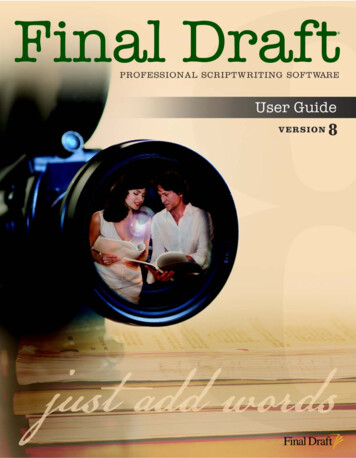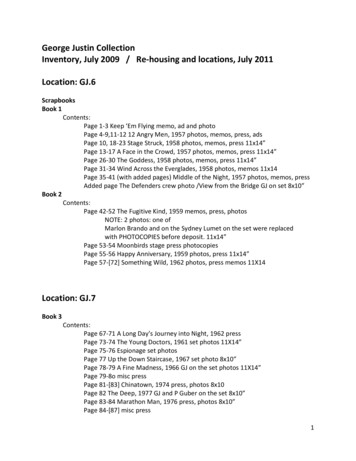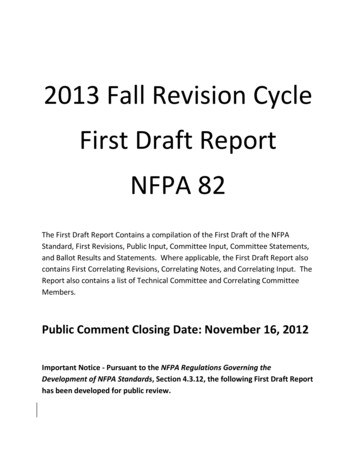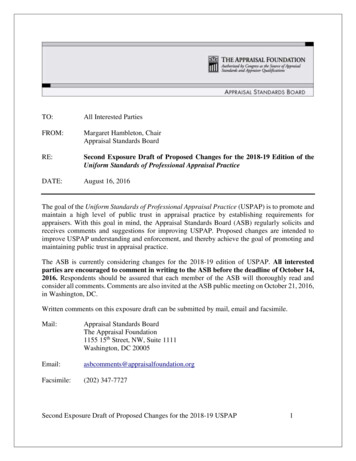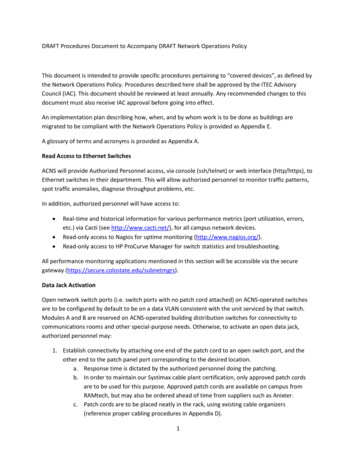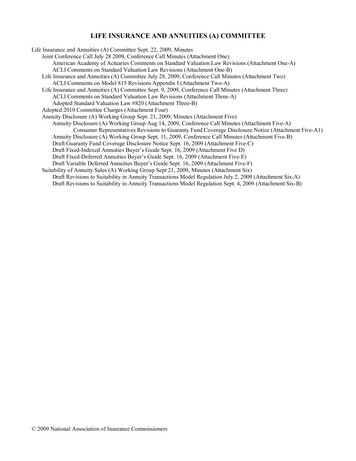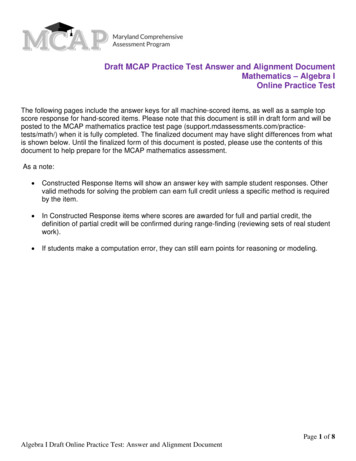
Transcription
Open Research OnlineThe Open University’s repository of research publicationsand other research outputsLearning to see: lessons from a participatoryobservation research project in public spacesJournal ItemHow to cite:Clark, Andrew; Holland, Caroline; Katz, Jeanne and Peace, Sheila (2009). Learning to see: lessons from aparticipatory observation research project in public spaces. International Journal of Social Research Methodology,12(4) pp. 345–30.For guidance on citations see FAQs.c 2009 RoutledgeVersion: Accepted ManuscriptLink(s) to article on publisher’s 68587Copyright and Moral Rights for the articles on this site are retained by the individual authors and/or other copyrightowners. For more information on Open Research Online’s data policy on reuse of materials please consult the policiespage.oro.open.ac.uk
Learning to see: Lessons from a participatory observation research project inpublic spacesAndrew Clark, Caroline Holland, Jeanne Katz, Sheila PeaceAbstractThis article outlines the development and implementation of participatory researchmethodology centred on observational techniques. It discusses the theoreticalunderstandings of the methodology and how it worked in practice. The researchexplored the use of public spaces by different social, ethnic and activity groups acrossthe course of a 12 month period drawing on the experiences of, and data collected bylocal, non-academic researchers who were trained in a non-participatory semistructured observation. The article discusses how this method was developed andimplemented and considers some of the issues around how participatory researchworks in practice.Keywords:Participatory research / Observation methods /Public space1
IntroductionParticipatory research is becoming an accepted method in social science research,increasingly recognised by funding bodies. In this article we describe recentexperience using a participatory framework in methods design, data collection andanalysis. The study sought to develop a set of robust methods for understandingsocial interactions in urban public spaces and utilised observational methods. Weoutline how this particular method worked in practice; why we embarked on such anendeavour; and what we learnt from it. In the first section of the article we chart theacademic context of the study and the substantive issues it explored. We then outlinethe specific participatory, non-participant observation method developed to meet theresearch requirements and consider the benefits and challenges associated with it. Inthe final section we present some reflections on being involved in the study, situatedin the context of ongoing debates about ethical, representative, and participatoryresearchMethodology: A participatory approachWhile participatory research has a relatively long history in development studies(Chambers 1997; Cooke and Kothari, 2001; Hickey and Mohan, 2004), this approachto collaborative research has also gained popularity across disciplines (e.g. de Koningand Martin, 2001; Pain, 2004; Peace, 1999). Its use has developed partly to satisfypredominantly post-positivist desires to question and challenge the principles andpractices of research. They have also emerged amidst calls for a more sociallyrelevant research agenda that better enables traditional „research subjects‟ to bringtheir own „voices‟ to the research process (Hickey and Mohan, 2004), and more „userinvolvement‟ in social policy development (Beresford, 2002). One consequence ofthis has been the questioning of power relationships between researchers andresearched. While some research tends to be concerned with „knowledge forunderstanding‟, much participatory research focuses on „knowledge for action‟, to beachieved through partnerships between traditionally-trained researchers and laypeople in a community (Cornwall and Jewkes, 1995; Kindon et al., 2007).Proponents argue that a participatory approach offers those traditionally described asthe subjects of research a say in determining what is being studied, and teachescommunity members the rudiments of research methodology so that they can assumecollaborative roles. Participation has the potential to engage people in all aspects ofthe research process. Consequently, participatory research is seen as a way ofachieving a more „relevant‟, morally aware and non-hierarchical research practice thatcan also be emancipatory (Kesby, 2000; Pain, 2004). Furthermore the outcomes ofthis approach are claimed to produce alternative truths or more efficient ways ofunderstanding complex situations and relationships (e.g. Moser and McIlwaine,1999).Insofar as most primary data collection in social science research requires interactionwith others, most can be described as participatory to varying degrees (Biggs, 1989;Cornwall, 1996). It has been argued that what identifies research as participatory isnot the methods used but the depth of participant involvement in the whole researchprocess (Emmel, 1997; de Konig and Martin, 1996).Participatory research is also situated in a more politicised agenda concerning powerand knowledge relationships in both research and society as a whole. Questions about2
control and power, and the potentially exploitative relationship between researcherand researched, led to attempts to facilitate collaboration in the research process,especially where the researched are service users. The researcher's role mayconsequently become that of facilitator working collaboratively with participants toachieve action orientated goals. The forms and extent of such collaboration vary fromparticipants being involved in every aspect, including establishing research priorities,collecting and interpreting data and disseminating results; to engaging in only part ofthe process (Peace, 2002). A common factor is the belief that participants developtheir own understandings of the research process, and the phenomena beinginvestigated, and consequently act upon this knowledge to better improve theirsituations.Perhaps ideally, participatory research is situated at what Biggs (1989) identified as acollegiate level of participation with “researchers and local people work[ing] togetheras colleagues with different skills to offer, in a process of mutual learning where localpeople have control over the process” (Cornwell and Jewkes, 1995; p1669). This ispartly dependent upon practical constraints of the operation of such research, thoughsome have questioned whether any research can ever achieve such a status (Cookeand Kothari, 2001). Rather than agonise over whether research should be labelledparticipatory or not, or becoming embroiled in debate about the depth or degree ofparticipation, we position our experiences within the discourse concerning the widerchallenges participatory research poses to research including issues of representationand constructing different sorts of knowledge. These are topics with which most postpositivist researchers engage, evident in practises aimed at destabilising unequalpower relationships, encouraging marginalised groups to have a say, and developingless exploitative research methods; even if not necessarily „participatory‟ in theepistemological sense of bringing about social action or change. In the studydiscussed here the primary intention was to produce knowledge about the everydayinteractions of people in public spaces. Inevitably this would produce findings that wehoped would be of use to policy makers and providers of services, but this was notintended to be action research as such. The „change‟ we wanted to address concernedboth understanding about public spaces in towns; and a development of our ownresearch methods toward engaging with local people. It was not our intention to effectdirect change in the town and we ensured that participants understood that the townwas a case study and that they were being invited to take part in academic rather thanaction research.Tensions and paradoxes of public space: the study contextCentral and local governments and numerous voluntary organisations have expressedcommitment to the idea of providing public spaces in the UK (DTLR, 2002; ODPM,2002). Studies have shown that good quality public spaces can benefit health andwellbeing, and local economies. Because, rhetorically at least, they are open toeverybody, they can allow „community‟ to exist and flourish (Cattell, 2004; Williamsand Green, 2001). A brief review of the literature identifies two prominent narrativesin current writing and thinking on public space in Europe and North America. Onerefers to the apparent decline of public space, linked to processes such asprivatisation, regulation and surveillance. The other offers a less pessimistic view, ofpublic spaces enabling diverse groups to come together to display their identities inthe public arena. Thus there is seemingly a paradox between public spaces as sites3
where difference is being eliminated, and sites were difference can be celebrated(Sennett, 1974; Mitchell, 2003; Sorkin, 1992; Young, 1990; Zukin, 1995).Precisely because they can be used by everyone, public spaces are frequentlyconsidered contested spaces; places where opposition, confrontation, resistance andsubversion can be played out over „the right to space‟ (Mitchell, 1995; 2003). Thesecontestations may involve people from a range of social groups based on gender, age,ethnicity, sexuality, (dis)ability, social class, and so on (Dines and Cattell, 2006;Malone, 2003; Valentine, 1996). They may centre on the different meanings attachedto different spaces, or draw on deeper struggles about social representations, orcollective „myths‟, about spaces (Cresswell, 1996). How spaces are understood andused may also depend upon individual and group characteristics (e.g. Laws, 1997;Low 2000; Matthews et al, 2000; Mitchell, 1995; McDowell, 1999). Thus publicspaces are imbued with power relations; particular social groups can be encouraged,tolerated, regulated, and sometimes excluded from public space depending on thedegree to which they might be deemed „in‟ or „out‟ of place (Cresswell, 1996). It is inthis context that the research presented in this paper was conducted; aiming tounderstand who uses which spaces, when and how, and how behaviour is interpretedby those observing it. As Dines and Cattell comment (2006; 1), the evidence base onways in which different social and cultural groups use public space is thin (Williamsand Green, 2001). This study was driven by a desire to understand the temporal andseasonal patterns of usage of different public spaces in order to uncover some of theways in which time, as well as social and cultural representations and practices,impacts upon the use of public space. The study covered three types of public spaces:residential neighbourhoods, green open spaces and town centre spaces, and the sitesselected included indoor shopping centres, a market square, a park, a canal towpath,residential playing fields and suburban shopping plazas (Holland et al, 2007)1.Selecting observation as a research methodA mixed methods approach was used, comprising surveys and interviews as well asthe extensive observations that are the focus of this article. Observation has become astaple method in the social sciences (Angrosino, 2005; Wallace, 2005), usedfrequently in research exploring the actions of individuals in public spaces (e.g.Kellaher, 2007; Low, 2000; Lofland 1973; Southwell, 2007). However, whilemethods such as participatory diagramming and mapping (Emmel and O‟Keefe, 1996;Kesby, 2000), photography (Chaplin, 2005), diaries (Johnson and Bytheway, 2001)and video (Kindon, 2003) have been reported, we contend that observation has notbeen used extensively in a participatory capacity.Madge and Harrison‟s (1938) summation of the benefits of observation methods stillrelevant today. These include; being able to directly observe the behaviour of individuals and groups infers a „facevalidity‟ that ensures, to a degree, that social realities can be simultaneouslyobserved, documented and analysed by the researcher,1The research was funded by the Joseph Rowntree Foundation for 18 months. Of this, 12 months wasdedicated to data collection, including user surveys, semi-structured interviews and the observationmethods discussed here. The research aimed to provide detailed, „real life‟ data about how differentpeople used different public spaces over the course of one year, and to analyse how interactions inthese spaces differ by age, gender or race/ethnicity4
observation methods enable researchers to document and understand the contextwithin which activities and events occur, firsthand experience of behaviours and events in their setting (or context) enablesinductive inquiry rather than, necessarily, reliance on prior conceptualizations, observation has the potential to reveal the mundane, routine activities thatcollectively make up those practices of everyday life that may escape the discursiveattention of participants, observation may permit the documenting of the life worlds of individuals who areunable to express their lived experiences verbally, through observation it is possible to understand what people may be unwilling orunable to discuss through other, predominantly verbal (interview and survey)methods.It was for these reasons that the observation method formed a major component ofthis research. The strategy was driven by a desire to get a little closer to „what reallyhappens‟ in public spaces to expand on more commonly researched aspects of whatpeople think happens, or what people say happens within them. In order to cover asmuch ground as possible, over an extended time-frame, the involvement of manypeople working part-time offered a practical solution to the type of observation thatwe hoped to accomplish. We now discuss the development of the participatoryobservation method, describing how we anticipated the method might work, and howit worked in practice.Non-participative, semi-structured observationA non-participative, semi-structured observation method was devised for recordingbasic data about the characteristics, location and activities of groups and individualswithin selected observation sites.2 Following a trial period, it was clear that the publicspaces selected for observation were too large and complex to observe without furthersub-division into „micro-sites‟. Figure 1 exemplifies the elements involved in one site,an indoor shopping mall, which was subdivided into four micro-sites. For each microsite an observation sheet was devised that comprised an outline diagram of keyfeatures and a matrix for recording the demographic characteristics (approximate age,gender, and visible ethnicity) of people using the site and any interactions betweenthem.A research method was required that was both structured - to enable comparisonsbetween sites and across different times, and flexible - to enable the complexity ofactivities in public space to be recorded. The method also needed to be clear enoughfor a large number of non-academic researchers to conduct without the „supervision‟of academics. The ethnographic approach devised for this study encouragedobservers to focus their attention on the micro-locations within each study location,and then on particular individuals, activities or groups of individuals within them.This produced a more nuanced account of site-specific geographies of public space,revealing strategies and locations of territorial practices by certain groups, andproducing detailed observations on interactions.2Here a distinction is being made in the traditional sense between „participative‟ and „nonparticipative‟ observation. The method was „non-participative‟ given the minimised interactionbetween the observers and any users of the public spaces. However, the research itself remainsparticipatory in that it involved „non-academic‟ co-researchers.5
Figure 1. Sample observation site (from Holland et al., 2007; p13)[Place Figure 1 here]Observation in practice: recruitment and trainingOver twelve months (October-October), more than sixty people (Table 1) wererecruited to the project through local voluntary groups and subsequent snowballingfrom recruited co-researchers. They underwent an intensive day of training beforecommitting to the project. We aimed to recruit a sample of participants who wererepresentative of the diversity of town‟s population, purposefully recruiting throughvoluntary groups serving younger and older people3. A decision to offer payment forthis work was taken because it was important to acknowledge the level ofcommitment involved in undertaking this work in all weathers and various times ofday and night. Given our aim to involve a range of people with differentbackgrounds, it was clear that some people would not be able to take part withoutrecompense. Payment for time worked (reported through timesheets) was based on astandard consultancy rate offered by our host institution. Co-researchers wereresponsible for their own tax returns and interactions with benefits agencies.In the recruitment literature and at initial meetings the participants were variouslyreferred to, and called themselves, „volunteers‟ or „observers‟. Over time there wasdiscussion in group meetings about the nature of the role and the most appropriatename for it. „Volunteers‟ was felt inappropriate because of the payments; „observers‟was fine for describing the observation itself, but for some it failed to capture theirinvolvement in reflection and analysis – and as the academics also carried outobservations „observers‟ could be ambiguous. To take these ideas on board and toreflect the sense of a co-production of knowledge, the term „co-researchers‟ wassuggested and this became the favoured term for the context of the whole study.During initial training and ongoing supervision in the field we were further able to vetco-researchers on their ability to collect and return robust data. Seven training eventswere held over the year consisting of two hours of 'classroom' based discussion whenparticipants met the academic team, were introduced to the rationale of the project,the observation method, and research ethics and safety procedures. Confidentialitywas taken very seriously and co-researchers received instruction on the importance ofnot identifying known individuals in their data. This was followed by a period of'hands on' observing at some of the research sites supervised by the academic team.Training concluded with a debriefing session when co-researchers were able todiscuss further their role (if any) in the project and clarify any further concerns. Coresearchers were provided with a project Handbook and follow-up support: membersof the academic team were on hand by telephone and in person to offer practical (andincreasingly, motivational) support whenever people were in the field.3More discussion of our recruitment strategy is available in Clark et al., (2005).6
Table 1: Observers receiving initial training across 12 months of the projectMaleFemaleTotalUnder 2410172725-4941115Over 5031821Total174663Between initial training and the completion of the first session of observation,seventeen people dropped out of the project for a number of reasons including feelingunsuited to the work and finding other paid work In all 46 people (aged 16-73 years)took part in observations across all days of the week and in all weather. A core groupcontinued to work with the project up to and beyond the 12 month fieldwork period:others could only commit shorter periods.Co-researchers were given guidance about what and how to observe in the context ofthe aims of the research. The intention was to give enough structure to theobservations to capture essential data and avoid observers feeling adrift, whileallowing enough flexibility for observers to adapt to changing situations and perhaps„deviate from the script‟ in the interest of the research question. Groups discussedhow to judge the age and „ethnicity‟ of others – in this case primarily by visual andsome auditory clues; how to select which groups/individuals to concentrate on; how todecide when to stick to the allowed route and timing, and when to deviate from it;what to do when the observation site was very busy or completely deserted. Coresearchers were also asked to distinguish between „objective‟ or categorical data andtheir own reflections on what they were observing. One member of each paircompleted the observation sheet (Figure 2) while the other completed an ethnographic„diary‟ extract to document a wider representation of activity. All co-researchers weretrained in both techniques to enable alternation.Figure 2. A completed observation sheet[Place Figure 2 here]Observation in practice: Safety and ethicsIt was emphasised that a non-participatory covert observational technique requiresobservers to avoid as far as possible any intervention in the situations they wouldobserve (with clear exceptions related to safety and legal requirements). Coresearchers were instructed to be as 'invisible' as possible and not interrupt activitiesand behaviours in the places they were investigating. However the research was not„secret‟ and if approached about what they were doing, they were to give the enquirera handout about the project. In practice, co-researchers were seldom approachedexcept for a small number of occasions in either the municipal park (generally bymembers of the public); inside a privately owned shopping centre (always by securitypersonnel); or by friends.During the study we periodically observed the co-researchers in action, unannounced.From this it became clear that in busy and moderately busy environments it wasdifficult to identify them and most of the general public passed them by without aglance. In very quiet or deserted environments and later in the evening they weremore obvious so during late night sessions co-researchers were always paired with an7
academic. All co-researchers were instructed at the outset to leave any situationwhich they found uncomfortable and to inform the duty academic contact if thishappened.Other ethical issues raised by the method were discussed in training, informal meetingwith the academics and at subsequent meetings. These included the ethics of watchingpeople and recording personal judgements of their activities including what to do inthe case of observing a crime or misdemeanour. In such cases co-researchers weretold to follow their own code of ethical behaviour and to „act as they would if theywere not in observation mode‟. The research was reviewed by our institution‟s ethicscommittee and we followed the British Psychological Society guidelines forconducting ethical observations in public spaces (BPS, 2006).Reflections on the research methodManaging expectationsOne claim of a participatory approach is a more transparent research process andperhaps democratisation of the use of 'public‟ funding. However this openness canexpose the research and researchers to criticism, especially if things do not go strictlyto plan and we were expected to give a good account of the research and its purpose.The interpretive, exploratory and participative aspects of the method were oftenquestioned by potential observers and others. Thus participants as well as„professional researchers‟ using participative methods need to be able to deal withpublic scrutiny, including being able to outline what might be the purpose andexpected outcomes of the research.Throughout the research we needed to convey our academic requirements and thoseof the funding body and methodological understandings of ethnographic observationto the team of co-researchers who were completing the bulk of the observations. Ofcourse, uncertainty about, and the relinquishing of some of the „control‟ over, aresearch project is one of the principals of participatory methodologies (Chambers,1994; 1997) that has been much critiqued (Cooke and Kothari, 2001). We intended toembrace some of the uncertainty of the approach by „handing over‟ part of the datacollection process to co-researchers. In practice this meant that the data coming infrom the field was variable in quality and completeness and dealing with this as wellas discussing it with co-researchers individually and in groups became timeconsuming especially for the academic leading the field work. Even with support, notall of the observers could do the work to a rigorous standard, yet others consistentlyturned in excellent and thoughtful reports. The use of participatory, inclusive researchrequires an acceptance of some tension between capacity building and the demand forrigorous data. To capture greater understanding of this role, interviews were carriedout with the co-researchers to explore their views on the experience of co-production.Nevertheless, once they had committed to the project most co-researchers found thatthe method developed their enthusiasm for observation. Many discussed the pleasureof discovering that they were now more observant when out and about, even while not„officially‟ observing for the project. Some particularly relished the opportunity to beflexible within the research, for example in identifying and suggesting otherobservation locations; dodging security officers and CCTV cameras (and in doing so,learning some of the spatial practices of those less privileged); and working alongside8
others of different ages, social backgrounds and knowledge of the town. On the otherhand the need for a structured process perhaps contributed to a few observers‟reluctance or lack of confidence about wavering from what they interpreted as strictinstructions.Some co-researchers were keen to look for something „extra-ordinary‟ in the ordinaryor conversely to seek the mundane in the unusual. In part this was driven by a desireto produce „interesting‟ or „relevant‟ data and make a „real contribution‟ to theresearch or offer „value for money‟. Occasionally this came into conflict with our aimof observing and documenting „the ordinary‟ per se, the better to understand it. Herethe iterative nature of the feedback and further fieldwork gave opportunities to discussagain the nature of knowledge and what the project could hope to discover.MotivationThe project had begun in an advantageous position in that the funding body waswilling to fund the payment of participants and to support the uncertainties of this wayof working. The question of payment is a vexed one (Russell et al., 2000; Thompson,1996) and raises questions about whether co-researchers were working alongside orfor the academic team. Payment was undoubtedly a key motivating factor, but someobservers described a sense of growing professionalism and attachment to the study,determined to “to see it through to the end”. Feedback from participants suggests thatpayment as such was appreciated as an acknowledgement of serious respect for theirinvolvement, and that the rate of payment was significant in the retention of someparticipants.In terms of the practicability of paying lay researchers, we had seriouslyunderestimated the amount of time needed to collect the field data and checkindividuals‟ contributions against their allocated time sheets and the observationschedules. We also quickly discovered that lay participants are unlikely to be familiarwith the workings of a university and its financial systems, and that universitysystems may not be geared up to respond to individuals not accustomed to workingwithin large systems. A good deal of time and energy was spent on marrying the twosets of expectations - pointing up the need for flexible and creative administrativearrangements to deal with lay participants in academic research.Observation as a participative and iterative method of inquiryThe participatory process can present an approach to research that favours a moreflexible, circular process of knowledge formation (Kindon et al., 2007). Ourparticipatory observational research involved reflection on what was observed, thequestions guiding the observations, and the theoretical underpinnings of the research,leading to further data collection. The opportunity for reflection was central to theprocess and was facilitated through dialogue between academic researchers and coresearchers when data can be reassessed, interpretations questioned, and new avenuesfor inquiry presented. The ability to accommodate this dialogue is a crucial aspect ofthe participatory process and this was developed in the project through repeatedinteractions between academic and co-researchers, but also between co-researchers,building up a corpus of knowledge about public spaces in the town as narratives thatrecounted experiences in the field. However, the process of questioning, datagathering, and analysis is something that not all participants wanted to necessarilyengage with. Although all participants received the same amount of formal training,9
it became clear that those with past experience of conducting research produceddifferent sorts of observations to those without. Despite considerable „pre-planning‟ toensure all observers could begin from the same starting point, reflecting our initialdesire for uniform observations, this ultimately remained an impossible task thatdenied the histories and experiences of the observers as individual agents. Moreovernot all participants wanted to engage in all parts of the research process frombeginning to end.Claims about truth have historically privileged the views of trained experts over thoseof „ordinary‟ people (Foucault, 1980). This remains manifest in much social researchwhere knowledge („truth‟) comes from experts (researchers, scientists etc.) whose jobis to present the „truth‟ about other people‟s lives. In theory, participatory methodscan offer a way of renegotiating the subordination of „ordinary‟ knowledge byproviding a way for „ordinary‟ pe
Malone, 2003; Valentine, 1996). They may centre on the different meanings attached to different spaces, or draw on deeper struggles about social representations, or collective „myths‟, about spaces (Cresswell, 1996). How spaces are understood and used may also depend upon individual and group characteristics (e.g. Laws, 1997;
